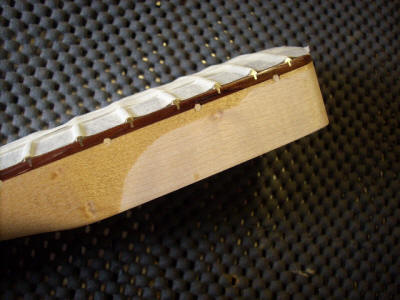'63 Strat Replica
The body has the plugged tooling jig holes just like the originals. You will only see these two "beauty spots" when the finish gets chipped in that area, but if it does, it will look authentic.
The Fender finishing process in the 60's started with a dipped yellow analin stain coat, everything should be stained yellow , unlike the later steps where the hanging stick produces the bare area in the neck pocket. Even custom colour finishes will usually be over a stained yellow body, although exceptions do occur.
Prior to the cellulose coats the hanging stick is attached. Fender started using the sticks in 1962, prior to that the guitars were painted on a Lazy Susan , the front sprayed first with the guitars resting on 4 nails driven into the front under the pickguard area whilst the back was sprayed. The nails were still used for a couple of years after the adoption of the paint stick handle to lay the guitars flat whilst drying. Original guitars should show 4 nail holes, with no finish in them, as the nails are kept in throughout the finishing process. The pencil date is also added to the trem cavity.
In the 1960's Fender used a catalysed sealer called Fullerplast. This cured quickly and provided a good flat surface to apply the sunburst coats too, meaning less finish build up and thinner overall finish and a quicker finishing time. The sealer is still available today, although Fender no longer use it. After applying the catalysed sealer I sprayed the red sunburst cellulose coat, avoiding the area under the pickguard. Then the black cellulose was applied followed by clear cellulose top coats. The nitrocellulose finish was then left to cure whilst I made a start on the neck.
The neck started out as two pieces of wood, American maple and Brazilian Amazon rosewood. After thickessing down to size the machining and shaping can begin. The guitar will have a curved "veneer" fretboard in keeping with a '63 instrument.
After the truss rod channel is routed the neck is cut out and routed flush to a template, note the template is attached to the neck with screws, these screw holes are left unplugged. Original 60's Fender have these tooling holes visible on the back of the neck between the D & G string tuners and on the neck heel.
The truss rod nut hole is drilled and the truss rod fitted with a maple fillet over the top.
The headstock is thicknessed down and the neck face cambered.
The fretboard is fitted, fret slots cut and handmade replica clay dots fitted. Then after drilling the stepped machinehead holes attention turns to shaping the neck.
An original '63 neck was on hand for comparison as the neck was hand shaped using rasps, spokeshaves, scrapers and various sanding sticks.
After fretting the transition area between the head and fretboard is shaped and an unbleached bone nut fitted.

As part of the finishing process the neck was given a slight stain to replicate the aging of the wood, the areas under the tuners and around the neck pocket were masked off, If removed the neck will look authentic, especially with this:
2 = code for Stratocaster, JUN63 = month and year, B = code for 1 5/8 nut width
The wiring harness: featuring Seymour Duncan APS1 pickups, CTS pots, CRL switch, Switchcraft jack, cloth covered wire and Luxe repro red dime cap.
The finished guitar after a trip in the GuiTardis